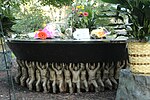The Confederate Monument, University of North Carolina, commonly known as Silent Sam, is a bronze statue of a Confederate soldier by Canadian sculptor John A. Wilson, which once stood on McCorkle Place of the University of North Carolina at Chapel Hill (UNC) from 1913 until it was pulled down by protestors on August 20, 2018. Its former location has been described as "the front door" of the university and "a position of honor".Establishing a Confederate monument at a Southern university became a goal of the North Carolina chapter of the United Daughters of the Confederacy (UDC) in 1907. UNC approved the group's request in 1908 and, with funding from UNC alumni, the UDC and the university, Wilson designed the statue, using a young Boston man as his model. At the unveiling on June 2, 1913, local industrialist and UNC trustee Julian Carr gave a speech espousing white supremacy, while Governor Locke Craig, UNC President Francis Venable and members of the UDC praised the sacrifices made by students who had volunteered to fight for the Confederacy. The program for the unveiling simply referred to the statue as "the Confederate Monument", with the name "Soldiers Monument" also being used around the same time. The name Silent Sam is first recorded in 1954, in the student newspaper The Daily Tar Heel.Beginning in the 1960s, the statue faced opposition on the grounds of its racist message, and it was vandalized several times during the civil rights movement. Protests and calls to remove the monument reached a higher profile in the 2010s, and in 2018, UNC Chancellor Carol L. Folt described the monument as detrimental to the university, and said that she would have the statue removed if not prohibited by state law. Increased protests and vandalism resulted in the university spending $390,000 on security and cleaning for the statue in the 2017–18 academic year. On the day before fall classes started in August 2018, the statue was toppled by protesters, and later that night removed to a secure location by university authorities. A statement from Chancellor Folt said the statue's original location was "a cause for division and a threat to public safety," and that she was seeking input on a plan for a "safe, legal and alternative" new location.UNC-Chapel Hill's board of trustees made a recommendation in December 2018 that the statue be installed in a new "University History and Education Center" to be built on campus, at an estimated cost of $5.3 million, but this was rejected by the university system's board of governors. The pedestal base and inscription plaques were removed in January 2019, with a statement from Chancellor Folt citing public safety.In November 2019, in response to a lawsuit from the Sons of Confederate Veterans (SCV), UNC donated the statue to the group, with a $2.5 million trust for its "care and preservation", on the condition that the statue would not be displayed in the same county as any UNC school. However, in February 2020 the settlement was overturned by the judge who originally approved it, who ruled that the SCV lacked standing to bring the lawsuit.










